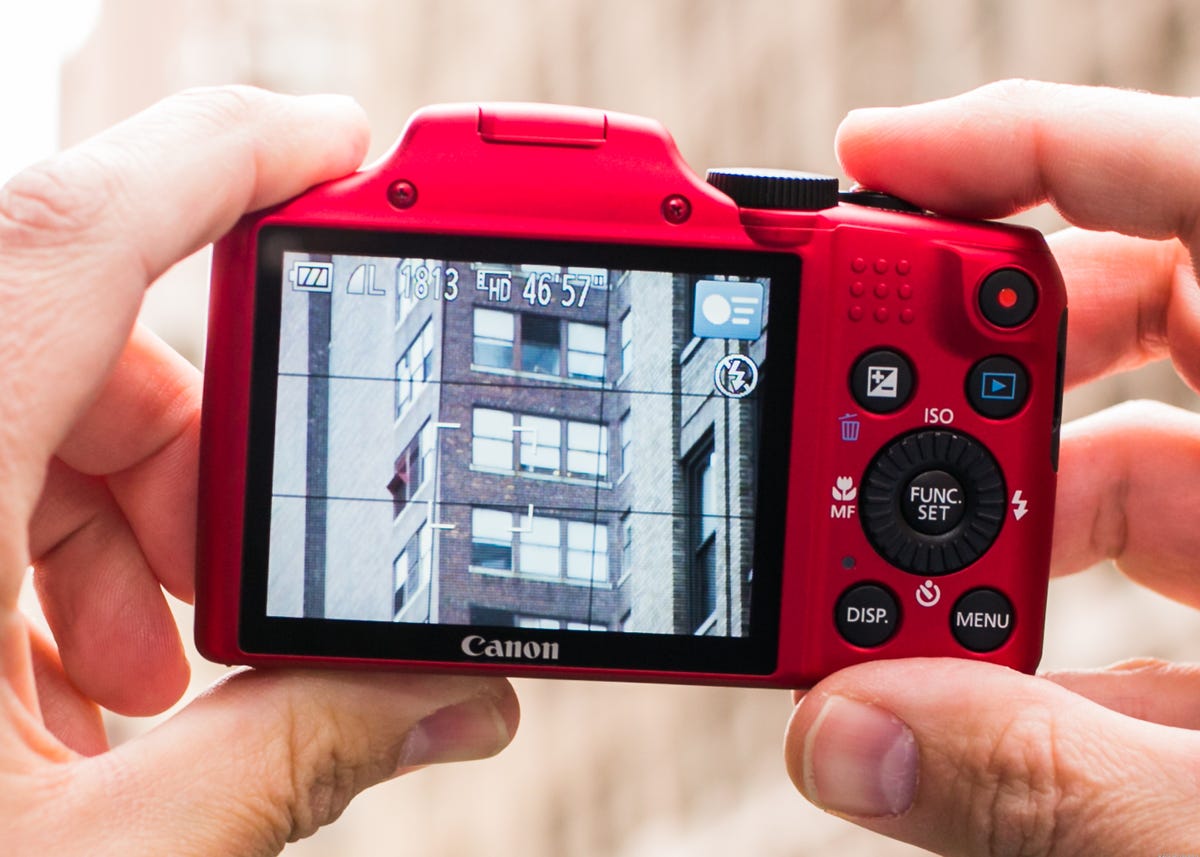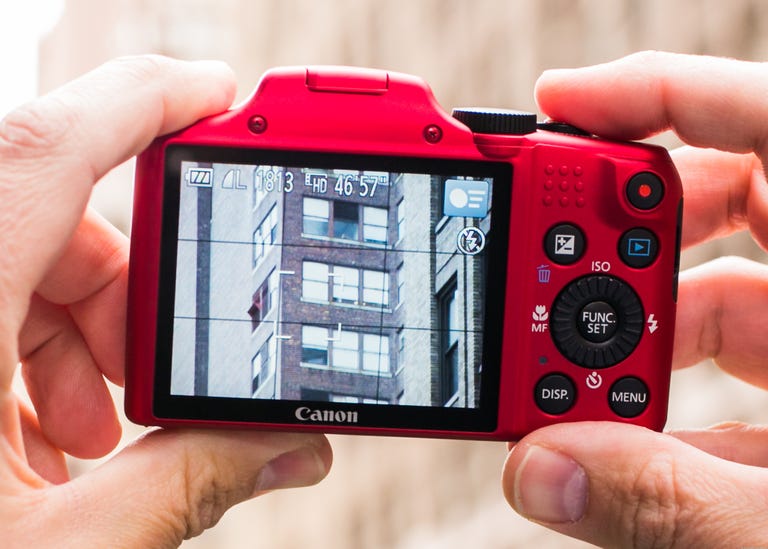 Why You Can Trust CNET
Why You Can Trust CNET Canon PowerShot SX170 IS review: No AA batteries, but still good photos, features for the money
Its AA batteries might be gone in favor of a rechargeable battery, but this budget-friendly compact megazoom still has other things to make it worthwhile.
Editors' note: The design, features, and shooting options are identical between the Canon PowerShot SX170 IS and the
The Good
The Bad
The Bottom Line
The Canon PowerShot SX160 IS was one of my favorite cameras to recommend to those looking for a good-quality point-and-shoot with semimanual and manual controls that takes AA-size batteries (and still is). For the follow-up SX170 IS, the good news is the camera retains almost all of the features of its predecessor.
The bad news is, AA batteries didn't make the cut, and Canon has switched them out for a rechargeable lithium-ion pack. This does mean the body is smaller and lighter and has better battery life compared to alkaline batteries, but you lose the convenience of being able to buy batteries almost anywhere.
Still, if you're on a budget and want a camera with semimanual and manual controls, but don't need to capture fast-moving subjects, the SX170 IS is available.
Photo quality
Canon's lower-end PowerShots generally produce some of the best photos you'll get from inexpensive point-and-shoots, and the SX170 IS is no different. Though you probably won't want to use its photos at full size, the SX170 IS overall produces very nice photos, especially for its price and features.
Pixel peepers will see noise even at ISO 100, but it's not noticeable at reduced sizes. Up at ISO 400 is where it starts to be more visible. Going above that, you'll start to see more color noise, artifacts, and loss of detail. The camera definitely favors dropping shutter speed over raising ISO when left in auto. That's good in general, but if you're not paying attention it could result in blurry photos.
The 720p video quality is good, and better than I've seen from some entry-level full HD camcorders I've tested. But, as with its photos, you'll see more noise the less light you have. Also, you may notice some vertical smear when shooting bright light sources. This is common with consumer CCD sensors.
The lens does zoom while recording and when it's zooming in you will hear slight motor sounds picked up by the stereo mics in front on very quiet scenes. Overall, though, for capturing the occasional clip for Web sharing, it does a fine job.

Shooting performance
Though the SX170 IS shoots faster than models prior to the SX160 IS, it still has the bottlenecks created by a two-generations-old image processor and a slow CCD sensor. Canon did update the autofocus system with the SX160, however, so shutter lag is more reasonable at 0.3 second in bright lighting and 0.5 second in low-light conditions.
The camera starts up and fires off its first shot in about 2 seconds. Shot-to-shot times averaged 1.5 seconds, while turning on the flash slowed that down to 4.7 seconds. Continuous shooting speeds are nothing special, at 0.8 frame per second with focus and exposure set with the first shot. The camera does have continuous with AF (a rarity) that captures at a slow 0.6 fps.
Unless you're shooting outdoors in bright daylight conditions, I would not recommend this camera for trying to capture fast-moving subjects such as sports, or kids and pets. Even then, I wouldn't use the zoom lens to do it. This camera's performance is fine for still or slow-moving subjects, though.
Design and features
The downsides of having a long zoom lens and AA batteries for power, are size and weight. With Canon eliminating the AA batteries, the body does get smaller and lighter. However, it's not really enough to make it more pocketable, and is only about an ounce and a half lighter than the SX160.
That said, its bigger size does make it easier to handle, and it does have a larger grip on the front. Plus, the weight helps keep the camera a little steadier when shooting.
| Canon PowerShot SX170 IS | Nikon Coolpix L620 | |
|---|---|---|
| Price (MSRP) | $179.99 | $179.95 |
| Dimensions (WHD) | 4.3x2.8x1.7 inches | 4.3x2.7x1.4 inches |
| Weight (with battery and media) | 8.9 ounces | 8.4 ounces |
| Megapixels, image sensor size, type | 16 megapixels, 1/2.3-inch CCD | 18 megapixels, 1/2.3-inch BSI CMOS |
| LCD size, resolution/viewfinder | 3-inch LCD, 230K dots/None | 3-inch LCD, 460K dots/None |
| Lens (zoom, aperture, focal length) | 16x, f3.5-5.9, 28-448mm (35mm equivalent) | 14x, f3.3-5.9, 25-350mm |
| File format (still / video) | JPEG/H.264 AAC (.MOV) | JPEG/H.264 AAC (.MOV) |
| Highest resolution size (still / video) | 4,608x3,456 pixels/ 1,280x720 pixels at 25fps | 4,896x3,672/ 1,920x1,080 at 30fps |
| Image stabilization type | Optical and digital | Optical and digital |
| Battery type, CIPA rated life | Li ion rechargeable, 300 shots | AA (2, alkaline included), 150 shots |
| Battery charged in camera | No | No |
| Storage media | SD/SDHC/SDXC | SD/SDHC/SDXC |
| Built-in Wi-Fi/GPS | No/no | No/no |
The batteries and memory card slot are in a compartment accessed through the bottom of the camera. Unlike previous versions of this camera, the door doesn't lock, and although it closes firmly, after a lot of use (the battery is not charged in the camera) accidental opening could become an issue. On the right side of the body, under a small door, is a Mini-USB/AV port for connecting to a computer or external display (with an additional cable that's not included). The Mini-HDMI port on the SX160 didn't make it to the SX170.
Alkaline batteries don't provide the best battery life and add weight. Changing to a small rechargeable lithium ion battery on the SX170 does get you about twice the shot count as the SX160, but you always had the option to use rechargeables with that camera. Here, you're stuck buying a specific battery pack that needs to be charged in a separate charger. So, while battery life is improved, you lose the flexibility of using widely available batteries. If you're going out shooting for the day, you'll still want to bring spares, because using the zoom, cranking up the screen brightness, and shooting movies will all drop your shot count.
| General shooting options | Canon PowerShot SX160 IS |
|---|---|
| ISO sensitivity (full resolution) | Auto, 100, 200, 400, 800, 1600 |
| White balance | Auto, Daylight, Cloudy, Tungsten, Fluorescent, Fluorescent H, Flash, Custom |
| Recording modes | Auto, Program, Shutter-speed priority, Aperture priority, Manual, Scene, Live View Control, Creative Filters, Discreet, Movie |
| Focus modes | Face AF, Center AF, Macro, Normal, Infinity, Manual |
| Macro | 0.3 inch to 1.6 feet (Wide) |
| Metering modes | Multi, Center-weighted average, Spot |
| Color effects | Vivid, Vivid Blue, Vivid Green, Vivid Red, Neutral, Sepia, Black & White, Positive Film, Lighter Skin Tone, Darker Skin Tone, Custom (adjustment of contrast, sharpness, saturation, red, green, blue and skin tone are available) |
| Burst mode shot limit (full resolution) | Unlimited continuous |
Most point-and-shoots at this camera's price don't come with a large variety of shooting options or controls; they're mainly made for fully automatic shooting. Among the many modes on the SX170, however, are shutter-priority, aperture-priority, and manual. Available apertures at the wide end are f3.5, f4.0, f4.5, f5.0, f5.6, f6.3, f7.1, and f8.0; at telephoto you get f5.9, f7.1, and f8.0. Shutter speeds go from 15 seconds, down to 1/3,200 second. If that's too much control for you, you can switch to Program, and control everything but shutter speed and aperture.
Not interested in that much control? You'll also find Canon's reliable Smart Auto, which analyzes your subject and automatically selects an appropriate scene setting from 32 defined settings; standard scene modes such as Portrait, Landscape, and Fireworks; Discreet mode, which shuts off all noise and lights while shooting; and a Movie mode for capturing clips at resolutions up to 720p HD at 25fps in MOV format.
For those who are addicted to the photo filters of smartphone apps, Canon includes several of its high-quality Creative Filters: Fisheye Effect, Miniature Effect, Toy Camera Effect, Monochrome, Super Vivid, and Poster Effect. Another mode, Live View Control, lets you easily experiment with exposure and color while seeing your results onscreen before you shoot (the same goes for the filters). While some may consider these gimmicks which can be accomplished with software, they can be fun to play with if you're looking to do something different, and can actually help you set up your shot appropriately for the effect you're after.
Conclusion
Like the SX160 IS, the Canon PowerShot SX170 IS is almost a niche camera: a budget-friendly compact megazoom, with a large body, big buttons, and semimanual and manual shooting modes. If you want automatic modes, it has that, too. In addition, it's photo quality is some of the best you'll get in this class of camera, though, sadly, that's not saying much.


